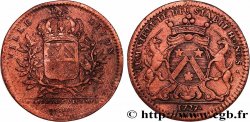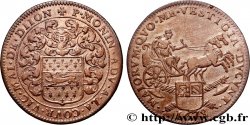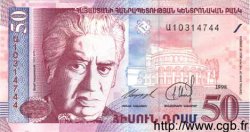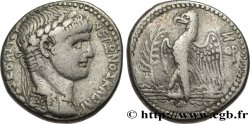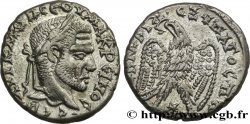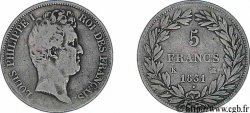fjt_059573 - DIJON (MAIRES DE ... et divers) Nicolas-Claude Rousselot 1769
non disponibile.
Articolo venduto sul nostro negozio
Prezzo : 12.00 €
Articolo venduto sul nostro negozio
Prezzo : 12.00 €
Tipo : Nicolas-Claude Rousselot
Data: 1769
Metallo : rame
Diametro : 29,5 mm
Asse di coniazione : 6 h.
Peso : 9,48 g.
Orlo : lisse
Grado di rarità : R1
Commenti sullo stato di conservazione:
Flan légèrement voilé
N° nelle opere di riferimento :
Diritto
Titolatura diritto : N. CL. ROUSSELOT CONER ME DES COMPTES VIC. MAY. DE DIJON 1766.
Descrittivo diritto : Armes de Dijon dans une couronne de laurier.
Rovescio
Titolatura rovescio : OMNIBUS IDEM.
Descrittivo rovescio : Armes couronnées et soutenues par deux lions.
Commento
Nicolas-Claude Rousselot, conseiller maître à la Chambre des comptes, fut nommé maire le 7 juin 1763. Il porte d’azur à la face d’or chargée d’une rose et accompagnée en chef d’un soleil et en pointe d’une brebis paissant. Il devint ensuite secrétaire en chef des États de Bourgogne
Les maires de Dijon
Dès l’époque de la naissance de la féodalité, la ville de Dijon possédait un maire et en général vingt magistrats municipaux, ou échevins. Ces magistrats sont confirmés en 1187, lorsqu’une charte de commune est accordée par le duc Hugues III. En 1192, pour la première fois, le maire dijonnais est élu.
A la fin du XIIIe siècle, ce maire prend le titre de vicomte maïeur, confirmé en 1477-1479 par Louis XI, qu’il gardera jusqu’en 1789. Depuis la fin du XVe siècle (1491), la charge de vicomte maïeur est anoblissante ainsi que celle d’échevin à compter du XVIe siècle. Le vicomte maïeur avait le droit de haute, moyenne et basse justice, le droit de scel et de visite. Les clefs de la ville lui sont confiées et il dirige les archers ainsi que les compagnies des sept quartiers, cette fonction militaire étant importante jusqu’au XVIIe siècle.
Fonction élective, le vicomte maïeur est élu par les habitants, ni mendiants, ni étrangers, qui payent la taille, en général la veille de la Saint-Jean. Cette élection a lieu sur le parvis de l'église saint Philibert. A partir de 1669, il est permis au maire de porter "une robe longue de satin plein, de couleur violet, doublée de satin rouge cramoisi, comme le prévôt des marchands de Lyon, avec chaperon de même étoffe et couleur bordée d’hermine" afin de se distinguer des habitants.
En 1692, la fonction de vicomte maïeur est transformée en office héréditaire tandis que l’élection n’est plus alors qu’une confirmation du choix royal fait par le gouverneur au nom du roi.
Voir leur liste complète à http://fr.wikipedia.org/wiki/Liste_des_maires_de_Dijon.
Nicolas-Claude Rousselot, master advisor to the Chamber of Accounts, was appointed mayor on June 7, 1763. It is azure with a gold face charged with a rose and accompanied at the top by a sun and at the bottom by a grazing sheep. He then became chief secretary of the States of Burgundy The mayors of Dijon From the time of the birth of feudalism, the city of Dijon had a mayor and generally twenty municipal magistrates, or aldermen. These magistrates were confirmed in 1187, when a municipal charter was granted by Duke Hugh III.. In 1192, for the first time, the mayor of Dijon was elected.
At the end of the 13th century, this mayor took the title of viscount mayor, confirmed in 1477-1479 by Louis XI, which he kept until 1789. Since the end of the 15th century (1491), the position of viscount mayor has been ennobling, as has that of alderman since the 16th century.. The Viscount Mayor had the right of high, middle and low justice, the right of seal and visitation. The keys to the city were entrusted to him and he commanded the archers as well as the companies of the seven districts, this military function being important until the 17th century..
An elective function, the Viscount Mayor is elected by the inhabitants, neither beggars nor foreigners, who pay the tax, generally on the eve of Saint John. This election takes place on the forecourt of the Saint Philibert church. From 1669, the mayor was allowed to wear \\\"a long robe of full satin, purple in color, lined with crimson red satin, like the provost of the merchants of Lyon, with a chaperon of the same fabric and color edged with ermine\\\" in order to distinguish himself from the inhabitants..
In 1692, the function of Viscount Mayor was transformed into a hereditary office while the election was then only a confirmation of the royal choice made by the governor in the name of the king..
See their full list at http://fr. Wikipedia. org/wiki/List_of_mayors_of_Dijon
Les maires de Dijon
Dès l’époque de la naissance de la féodalité, la ville de Dijon possédait un maire et en général vingt magistrats municipaux, ou échevins. Ces magistrats sont confirmés en 1187, lorsqu’une charte de commune est accordée par le duc Hugues III. En 1192, pour la première fois, le maire dijonnais est élu.
A la fin du XIIIe siècle, ce maire prend le titre de vicomte maïeur, confirmé en 1477-1479 par Louis XI, qu’il gardera jusqu’en 1789. Depuis la fin du XVe siècle (1491), la charge de vicomte maïeur est anoblissante ainsi que celle d’échevin à compter du XVIe siècle. Le vicomte maïeur avait le droit de haute, moyenne et basse justice, le droit de scel et de visite. Les clefs de la ville lui sont confiées et il dirige les archers ainsi que les compagnies des sept quartiers, cette fonction militaire étant importante jusqu’au XVIIe siècle.
Fonction élective, le vicomte maïeur est élu par les habitants, ni mendiants, ni étrangers, qui payent la taille, en général la veille de la Saint-Jean. Cette élection a lieu sur le parvis de l'église saint Philibert. A partir de 1669, il est permis au maire de porter "une robe longue de satin plein, de couleur violet, doublée de satin rouge cramoisi, comme le prévôt des marchands de Lyon, avec chaperon de même étoffe et couleur bordée d’hermine" afin de se distinguer des habitants.
En 1692, la fonction de vicomte maïeur est transformée en office héréditaire tandis que l’élection n’est plus alors qu’une confirmation du choix royal fait par le gouverneur au nom du roi.
Voir leur liste complète à http://fr.wikipedia.org/wiki/Liste_des_maires_de_Dijon.
Nicolas-Claude Rousselot, master advisor to the Chamber of Accounts, was appointed mayor on June 7, 1763. It is azure with a gold face charged with a rose and accompanied at the top by a sun and at the bottom by a grazing sheep. He then became chief secretary of the States of Burgundy The mayors of Dijon From the time of the birth of feudalism, the city of Dijon had a mayor and generally twenty municipal magistrates, or aldermen. These magistrates were confirmed in 1187, when a municipal charter was granted by Duke Hugh III.. In 1192, for the first time, the mayor of Dijon was elected.
At the end of the 13th century, this mayor took the title of viscount mayor, confirmed in 1477-1479 by Louis XI, which he kept until 1789. Since the end of the 15th century (1491), the position of viscount mayor has been ennobling, as has that of alderman since the 16th century.. The Viscount Mayor had the right of high, middle and low justice, the right of seal and visitation. The keys to the city were entrusted to him and he commanded the archers as well as the companies of the seven districts, this military function being important until the 17th century..
An elective function, the Viscount Mayor is elected by the inhabitants, neither beggars nor foreigners, who pay the tax, generally on the eve of Saint John. This election takes place on the forecourt of the Saint Philibert church. From 1669, the mayor was allowed to wear \\\"a long robe of full satin, purple in color, lined with crimson red satin, like the provost of the merchants of Lyon, with a chaperon of the same fabric and color edged with ermine\\\" in order to distinguish himself from the inhabitants..
In 1692, the function of Viscount Mayor was transformed into a hereditary office while the election was then only a confirmation of the royal choice made by the governor in the name of the king..
See their full list at http://fr. Wikipedia. org/wiki/List_of_mayors_of_Dijon








 Segnalare un errore
Segnalare un errore Stampate la pagina
Stampate la pagina Condividi mia selezione
Condividi mia selezione Fai una domanda
Fai una domanda Consegnare / vendere
Consegnare / vendere
 Descrittivo
Descrittivo


